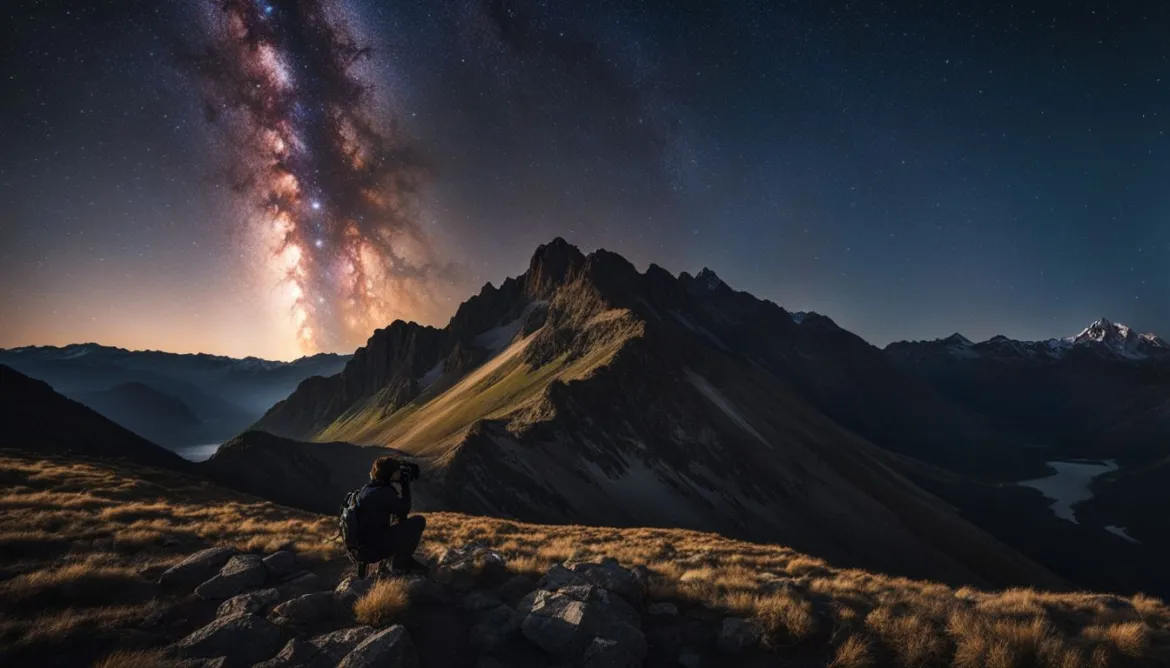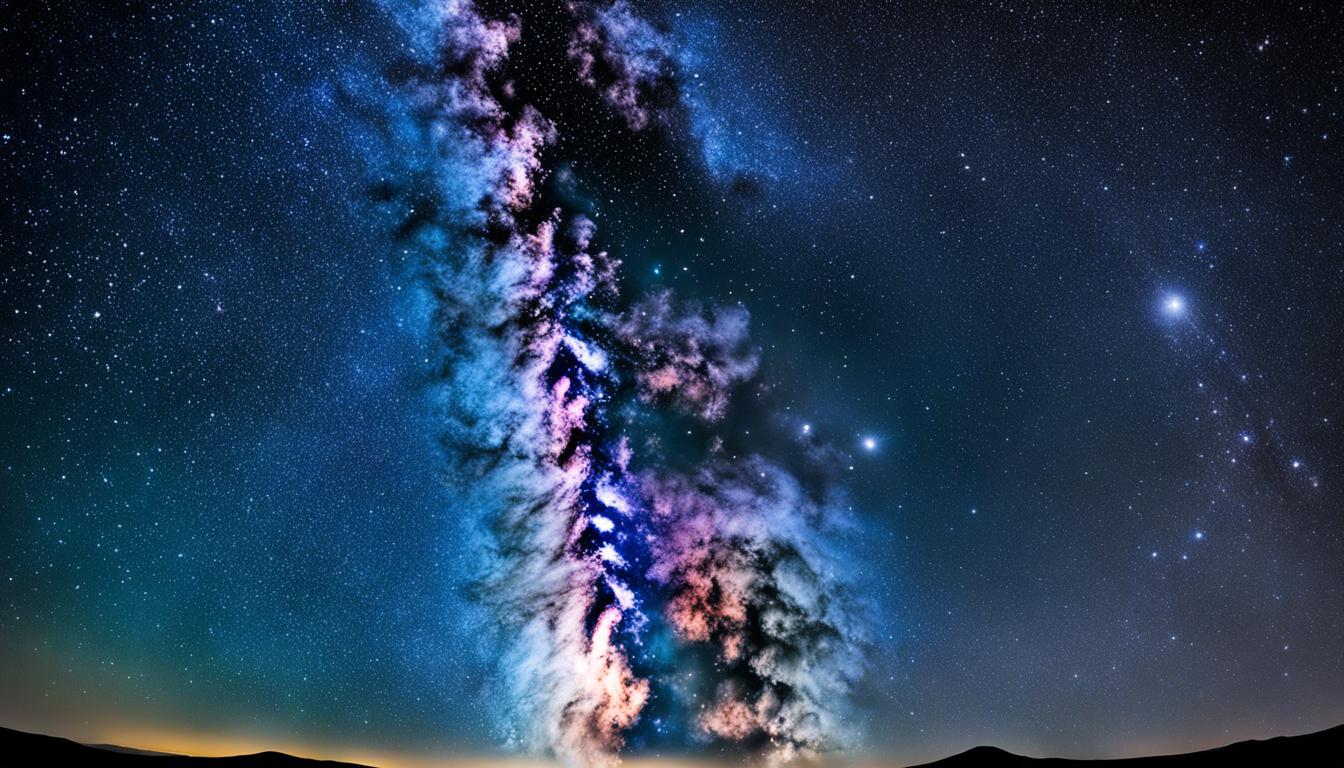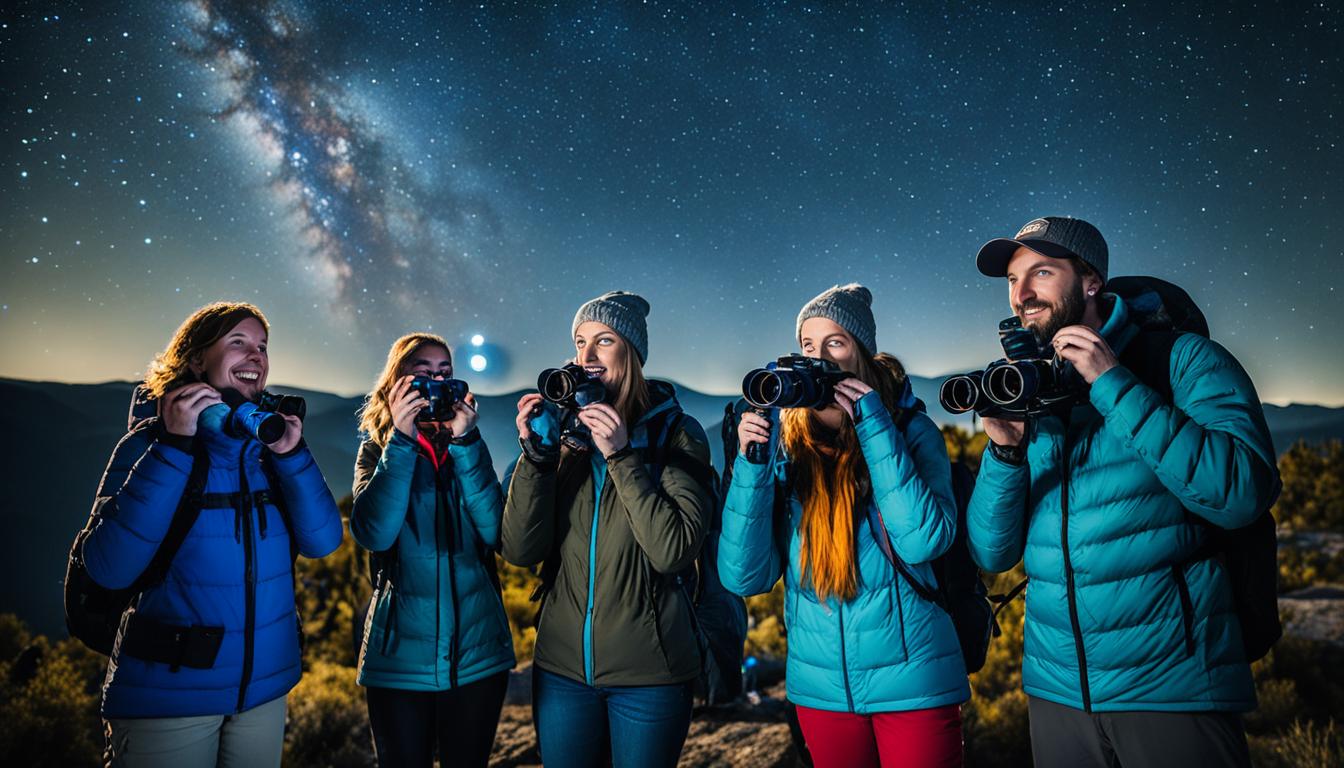Welcome to our comprehensive guide on understanding and using a star tracker for long exposures in astrophotography. If you’re passionate about capturing the beauty of the night sky and want to take your images to the next level, a star tracker is an essential tool that allows you to create stunning long-exposure photos without star-trailing. Whether you’re a beginner or an experienced astrophotographer, this guide will provide you with valuable insights and tips to help you master the art of capturing breathtaking images of the cosmos.
Key Takeaways:
- Using a star tracker is crucial for capturing long-exposure images of the night sky without star-trailing.
- Star trackers are commonly used with DSLR/Mirrorless cameras and telescopes.
- The Sky-Watcher Star Adventurer GTi is a reliable star tracker with advanced features.
- With a star tracker, you can capture deep-sky objects and reveal incredible details in the night sky.
- Polar alignment and balancing are important for accurate tracking with a star tracker.
The Types of Images You Can Take
With a star tracker, you can capture a wide range of images in astrophotography. It allows you to take long-exposure images that reveal deep-sky objects such as nebulae and galaxies. This is different from ultra-wide field shots of the sky. Star trackers give you the ability to dive into the deep sky and capture incredible objects. The California Nebula and the Pleiades are examples of deep-sky objects that can be photographed with a star tracker.
When using a star tracker, you gain the opportunity to explore the vast wonders of the night sky. By capturing long-exposure images, you can reveal the intricate details and stunning beauty of deep-sky objects that are otherwise invisible to the naked eye. Nebulae, galaxies, and other celestial phenomena come to life through the lens of your camera, allowing you to showcase their mesmerizing colors and intricate structures.
| Deep-Sky Object | Description |
|---|---|
| California Nebula | The California Nebula is a large emission nebula located in the constellation Perseus. It is often photographed for its distinct shape, resembling the state of California. |
| Pleiades | The Pleiades, also known as the Seven Sisters, is a star cluster located in the constellation Taurus. It is a popular astrophotography target due to its bright and beautiful blue stars. |
By venturing into the realm of deep-sky astrophotography, you can capture images that showcase the wonders of our universe. The intricate structures and ethereal beauty of nebulae and galaxies can be awe-inspiring, leaving viewers captivated by the vastness and mystery of the cosmos.
How to Use a Star Tracker
When it comes to astrophotography and capturing stunning long-exposure images of the night sky, a star tracker is an invaluable tool. By understanding how to use a star tracker effectively, you can unlock its full potential and take your astrophotography to new heights.
One of the first steps in using a star tracker is to ensure proper polar alignment and balance. Polar alignment involves adjusting the mount’s base so that it aligns with the celestial pole using tools like a polar scope. This alignment is crucial as it aligns the mount’s rotation axis with the rotation axis of the Earth, allowing for accurate tracking of the stars. A well-aligned star tracker ensures that the stars remain sharp and stationary during long-exposure photography.
Once your star tracker is properly aligned, it’s time to understand how it matches the apparent movement of the night sky. A star tracker achieves this by slowly rotating the camera in right ascension, which effectively freezes the stars in place during long exposures. This eliminates the limitation of star trailing, allowing you to capture longer exposure times and reveal more details in your astrophotography.
Using a star tracker opens up a world of possibilities in astrophotography. It allows you to capture breathtaking images of the Milky Way, deep-sky objects, and other celestial phenomena with stunning clarity and detail. Whether you’re an experienced astrophotographer or just starting out, mastering the use of a star tracker is essential for achieving professional-level results.
“A star tracker is like a guiding hand in the night sky, ensuring that your camera captures the beauty of the cosmos with precision and accuracy.”
With careful alignment, a star tracker eliminates star trailing and reveals the true wonders of the night sky. It enables you to experiment with longer exposure times, bringing out the intricacies of the stars, galaxies, and nebulae. By understanding how to use a star tracker effectively, you’ll have the power to create awe-inspiring astrophotography that leaves a lasting impression.
![]()
| Benefits of Using a Star Tracker | Considerations |
|---|---|
|
|
The Portability Factor
When it comes to astrophotography, having a portable star tracker can make all the difference. These compact and lightweight devices offer convenience and flexibility, allowing us to capture stunning images of the night sky in remote locations. Whether you’re chasing the perfect Milky Way panorama or exploring wide-angle nightscapes, a portable star tracker is an essential tool for any astrophotographer.
Unlike heavy equatorial telescope mounts, star trackers are designed with portability in mind. They are smaller in size and more affordable, making them accessible to photographers of all levels. Their lightweight nature means they can be easily transported, whether you’re hiking to a remote mountain peak or traveling to a dark sky location.
Portable star trackers often come equipped with polar scopes, which help us align with the celestial pole. This ensures accurate tracking of the stars throughout long exposures. The polar scope aids in finding the celestial pole, allowing for quick and easy setup in the field. With minimal time spent on setup, we can focus on capturing the beauty of the cosmos.
Not only are portable star trackers ideal for capturing wide-angle nightscapes and Milky Way panoramas, but they can also be used for moon and planet photography. Their versatility makes them a valuable addition to our astrophotography gear.
Benefits of a Portable Star Tracker
- Portability: Lightweight and compact design makes it easy to carry and set up in different locations.
- Accessibility: More affordable compared to heavy equatorial telescope mounts, making astrophotography accessible to a wider audience.
- Versatility: Suitable for capturing wide-angle nightscapes, Milky Way panoramas, moon, and planet photography.
- Quick Setup: Polar scopes aid in finding the celestial pole, allowing for efficient and accurate setup in the field.
Comparison Table: Popular Portable Star Trackers
| Star Tracker Model | Weight | Payload Capacity | Price Range |
|---|---|---|---|
| iOptron SkyTracker Pro | 2.2 lbs | 6.6 lbs | $299 |
| Sky-Watcher Star Adventurer Pro | 2.4 lbs | 11 lbs | $439 |
| iOptron SkyGuider Pro | 2.5 lbs | 11 lbs | $499 |
| Fornax Mounts LighTrack II | 3.3 lbs | 22 lbs | $1,099 |
| Sky-Watcher Star Adventurer GTi (2022) | 2.6 lbs | 11 lbs | $499 |
Popular Models in the “Star Tracker” Category
When it comes to astrophotography, having the right star tracker is crucial for capturing stunning celestial images. There are several popular models available in the market, each with its own strengths and weaknesses. Let’s take a closer look at some of the top choices:
iOptron SkyTracker Pro
The iOptron SkyTracker Pro is a reliable and user-friendly star tracker that is widely used by astrophotographers. It offers excellent tracking accuracy and can support camera setups with up to 6.6 pounds of payload. With its compact and lightweight design, it is highly portable and easy to set up in the field.
Sky-Watcher Star Adventurer Pro
The Sky-Watcher Star Adventurer Pro is another popular choice among astrophotography enthusiasts. It features a built-in polar scope for easy and accurate polar alignment. With a payload capacity of up to 11 pounds, it can handle larger camera setups and even small telescopes. The Star Adventurer Pro also offers advanced features, such as time-lapse and automatic panorama modes.
iOptron SkyGuider Pro
The iOptron SkyGuider Pro is a versatile and portable star tracker that offers excellent performance for both wide-field and telephoto astrophotography. It has a payload capacity of up to 11 pounds and features a built-in illuminated polar scope for precise alignment. The SkyGuider Pro also comes with a handy smartphone app that allows for easy control and tracking.
Fornax Mounts LighTrack II
The Fornax Mounts LighTrack II is a high-quality and precision-engineered star tracker. It is known for its exceptional tracking accuracy and stability, making it a popular choice among professional astrophotographers. With its robust build and a payload capacity of up to 11 pounds, it can handle heavy camera setups and telescopes.
Sky-Watcher Star Adventurer GTi (2022)
The Sky-Watcher Star Adventurer GTi is the latest model in the Star Adventurer series. It combines portability, ease of use, and advanced features such as GoTo functionality and autoguiding. With a payload capacity of up to 11 pounds, it can handle a wide range of camera setups and small telescopes.
When choosing a star tracker for astrophotography, it is important to consider factors such as portability, payload capacity, and additional features. Each model mentioned above offers unique benefits, so be sure to choose the one that best suits your specific needs and photography goals.
![]()
Basic Requirements for Successful Imaging
When it comes to long-exposure astrophotography, there are a few key factors that contribute to successful imaging. Let’s take a look at the essential equipment, location, and timing considerations:
Equipment
A crucial component for long-exposure astrophotography is a reliable tracking mount. This mount keeps the camera sensor aligned with the stillness of the night sky. One recommended tracking mount is the Kenko SkyMemo Tracker, known for its portability and quality.
In addition to the tracking mount, your camera should have excellent high-ISO performance and a manual bulb mode. This allows you to capture the faint details of celestial objects during long exposures.
The lens you choose also plays a vital role in your astrophotography. Opt for a lens that offers sharpness and detail, such as a wide-angle lens with a low aperture for capturing expansive nightscapes and stunning Milky Way shots.
Location
Finding a location with dark skies and minimal light pollution is essential for astrophotography. Light pollution can diminish the visibility of stars and other celestial objects. Seek out remote areas, away from city lights, to capture the true beauty of the night sky. Websites and apps like Dark Sky Finder and Light Pollution Map can help you locate ideal locations.
Timing
The best time for long-exposure astrophotography is during the new moon or close to it when the sky is darkest. This ensures optimal conditions for capturing the faint details and deep-sky objects. Plan your astrophotography sessions around moonrise and moonset times to avoid the interference of moonlight.
Remember, successful long-exposure astrophotography requires the right equipment, careful consideration of location, and proper timing. By following these basic requirements, you’ll be on your way to capturing breathtaking images of the night sky.
Conclusion
Understanding and using a star tracker for long exposures in astrophotography is a game-changer. With a star tracker, we can capture stunning celestial images that reveal intricate details of the night sky. By eliminating star trailing and allowing for longer exposure times, star trackers enable us to photograph deep-sky objects and create breathtaking astrophotographs.
Choosing the right star tracker is crucial for successful astrophotography. It’s important to consider factors such as portability, payload capacity, and additional features that align with our specific needs and preferences. With the right star tracker in hand, we can confidently explore the wonders of the cosmos and push the boundaries of our night sky photography.
Using a star tracker does require some technical knowledge and practice. Proper polar alignment and balancing of the mount are essential for accurate tracking. Additionally, understanding the basic requirements for successful imaging, such as using high-ISO capable cameras, selecting the right lens, and shooting in dark sky locations during optimal times, will further enhance our astrophotography results.
So, let’s embark on our astrophotography journey armed with the knowledge and tools to capture the beauty of the night sky. With a star tracker, we can elevate our long-exposure astrophotography and unlock the secrets of the cosmos, creating images that leave us in awe of the vastness and wonder of the universe.
FAQ
What is a star tracker?
A star tracker is a portable tracking camera mount designed for astrophotography. It allows you to capture long exposure images of space without star-trailing by tracking the motion of the stars.
How do star trackers work?
Star trackers work by aligning the mount’s rotation axis with the rotation axis of the Earth, allowing for accurate tracking of the stars. They slowly rotate the camera in right ascension, freezing the stars in place during long-exposure photography.
What types of images can I take with a star tracker?
With a star tracker, you can capture a wide range of images in astrophotography, including long-exposure images of deep-sky objects such as nebulae and galaxies.
Are star trackers portable?
Yes, star trackers are portable and lightweight compared to heavy equatorial telescope mounts. They are ideal for astrophotographers who want to travel to remote locations and capture wide-angle nightscapes and Milky Way panoramas.
What are some popular star tracker models for astrophotography?
Some popular star tracker models include the iOptron SkyTracker Pro, Sky-Watcher Star Adventurer Pro, iOptron SkyGuider Pro, Fornax Mounts LighTrack II, and Sky-Watcher Star Adventurer GTi (2022).
What are the basic requirements for successful long-exposure astrophotography?
Successful long-exposure astrophotography requires the right equipment, including a star tracker, a camera with excellent high-ISO performance and manual bulb mode, and the right location with dark skies and minimal light pollution.
How can I elevate my night sky photography with a star tracker?
By choosing the right star tracker and understanding how to use it correctly, you can capture incredible images of the cosmos with longer exposure times without star trailing, revealing deep-sky objects and details in the night sky.



